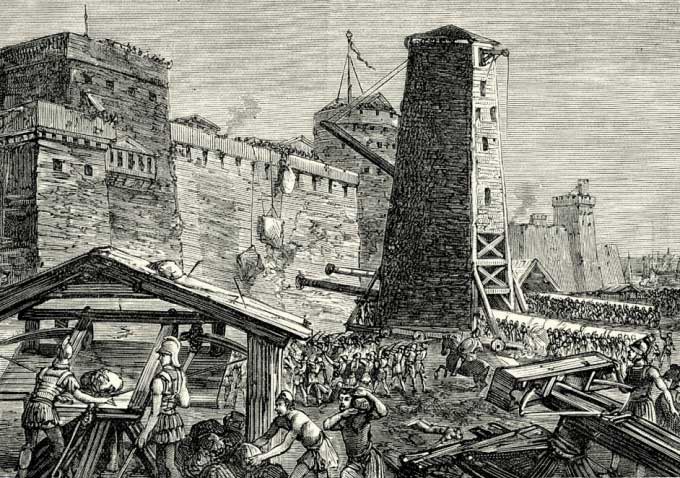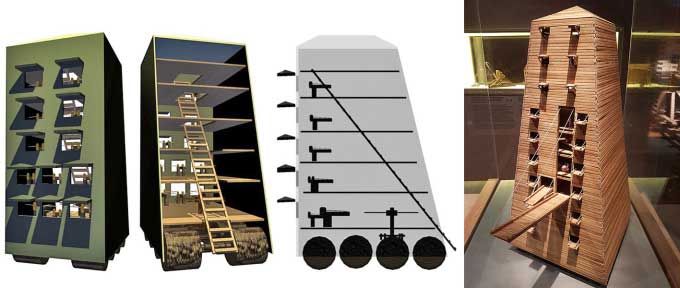Giant Weapon Tower Becomes Wonder of the Ancient World
Failed in the siege of the city more than 2,300 years ago, parts of the iron-clad wooden tower of Helepolis were melted down to build the Colossus of Rhodes.
In the late 4th century BC, after the death of Alexander the Great, the kingdom of Rhodes developed close commercial and cultural ties with the Egyptian pharaoh Ptolemy I, forming an alliance that controlled trade throughout the Aegean Sea. The Macedonian king, Antigonus I, felt threatened by this alliance. He feared that Ptolemy I might use Rhodes as a base to attack Macedonia, and that the Rhodians might even provide ships and supplies to the pharaoh.

Illustration of the siege of Rhodes. (Photo: Amusing Planet).
Antigonus I decided to break this alliance. In 305 BC, he sent his son and future king of Macedon, Demetrius, with a large fleet to besiege Rhodes. His first objective was to seize the island's harbor. Demetrius quickly built his own harbor next to the original one and a dike to protect his maritime operations. Meanwhile, his army ravaged the island and built a large camp on land adjacent to the city of Rhodes but still out of range.
During the battle, both sides used many technical devices such as mines and various siege engines, most notably Demetrius's giant siege tower called Helepolis , or "Taker of Cities".

3D simulation and cross section of the Helepolis tower (left) and a model of the tower at the Museum of Technology of Thessaloniki, Greece. (Photo: Gts-tg/Wikimedia/Evan Mason).
The tower of Helepolis is tapering upwards, about 40 m high, made of wood and covered with iron plates. Inside the tower is divided into several floors, where hundreds of men lie in wait to attack the walls with catapults and battering rams. For firing, the front wall of the tower is equipped with many cannon gates and protected by mechanically adjustable doors, lined with leather stuffed with wool and seaweed to prevent fire. The entire tower, weighing 160 tons, is mounted on eight wheels, each about 4.5 m high. It took 3,400 people working in groups to push and move the tower into the correct position in front of the wall.
As a result, the Rhodians attacked Helepolis fiercely, even destroying some of the iron plates that encased the tower, leaving the fragile wooden structure exposed. In order to protect Helepolis, Demetrius ordered the tower withdrawn. A year later, a relief force of several ships sent by Ptolemy arrived. Demetrius and his army abandoned the siege, leaving behind most of the machinery and weapons.
A decade later, the Rhodians melted down all the weapons left behind by Demetrius' army, including the iron plates from Helepolis, and sold the remains of the tower. With the money and materials such as bronze and iron, they erected the Colossus of Rhodes to commemorate their heroic battle against their enemy. The colossal statue was built from an iron frame with bronze plates attached to form a skin. The builders then filled the structure with stone blocks. The statue stood on a 15-meter-high marble pedestal. By 280 BC, the statue had been completed after 12 years of work.

A 1790 illustration of the Colossus of Rhodes. (Photo: Amusing Planet).
The Colossus of Rhodes lasted only 54 years. An earthquake struck Rhodes in 226 BC, breaking its knees and causing it to collapse. The pieces were eventually collected and melted down when Rhodes fell to the Arabs in 653. The bronze was sold to a Jewish merchant who needed over 900 camels to transport it all.
Although no longer standing, both Heliopolis and the Colossus of Rhodes have had a profound impact on modern culture. For example, the design of the Statue of Liberty in New York was inspired by the Colossus of Rhodes, considered one of the Seven Wonders of the Ancient World.
- How much is the world 'wonder' worth?
- China successfully operated the chimney 'filter' air pollution
- An odd ancient tower tomb population in Peru
- 11 interesting things you can know about the Big Ben clock tower
- Ancient 'beast' version of 4 meek modern creatures
- Discovering the mystery in the ground of ancient My Son tower
- Saudi Arabia built the tallest skyscraper in the world
- Two theories about the ancient Japanese sword of the giant
- Japan will have the highest television tower in the world
- My Son Sanctuary
- The ancient tower in the heart of the city hung over 5,500 telephone wires
- The greatest buildings in the world
 'Fine laughs' - Scary and painful torture in ancient times
'Fine laughs' - Scary and painful torture in ancient times The sequence of numbers 142857 of the Egyptian pyramids is known as the strangest number in the world - Why?
The sequence of numbers 142857 of the Egyptian pyramids is known as the strangest number in the world - Why? History of the iron
History of the iron What is alum?
What is alum?